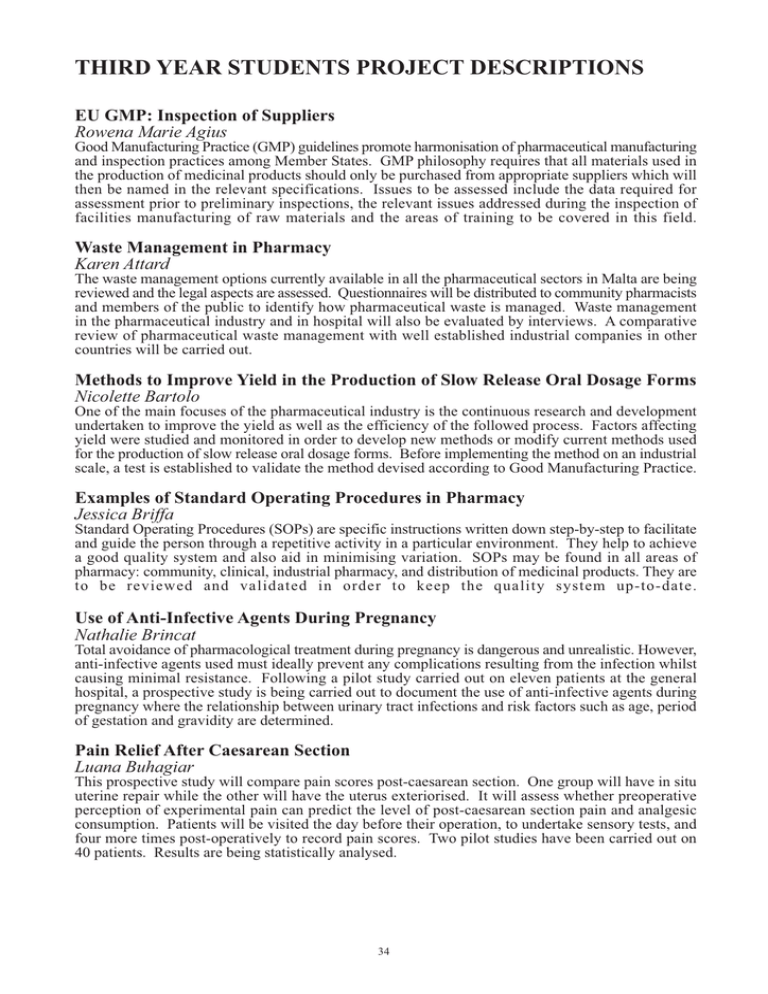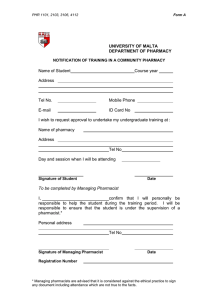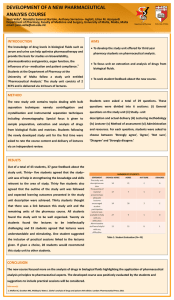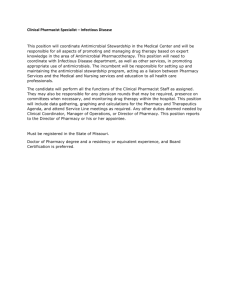THIRD YEAR STUDENTS PROJECT DESCRIPTIONS EU GMP: Inspection of Suppliers
advertisement

THIRD YEAR STUDENTS PROJECT DESCRIPTIONS EU GMP: Inspection of Suppliers Rowena Marie Agius Good Manufacturing Practice (GMP) guidelines promote harmonisation of pharmaceutical manufacturing and inspection practices among Member States. GMP philosophy requires that all materials used in the production of medicinal products should only be purchased from appropriate suppliers which will then be named in the relevant specifications. Issues to be assessed include the data required for assessment prior to preliminary inspections, the relevant issues addressed during the inspection of facilities manufacturing of raw materials and the areas of training to be covered in this field. Waste Management in Pharmacy Karen Attard The waste management options currently available in all the pharmaceutical sectors in Malta are being reviewed and the legal aspects are assessed. Questionnaires will be distributed to community pharmacists and members of the public to identify how pharmaceutical waste is managed. Waste management in the pharmaceutical industry and in hospital will also be evaluated by interviews. A comparative review of pharmaceutical waste management with well established industrial companies in other countries will be carried out. Methods to Improve Yield in the Production of Slow Release Oral Dosage Forms Nicolette Bartolo One of the main focuses of the pharmaceutical industry is the continuous research and development undertaken to improve the yield as well as the efficiency of the followed process. Factors affecting yield were studied and monitored in order to develop new methods or modify current methods used for the production of slow release oral dosage forms. Before implementing the method on an industrial scale, a test is established to validate the method devised according to Good Manufacturing Practice. Examples of Standard Operating Procedures in Pharmacy Jessica Briffa Standard Operating Procedures (SOPs) are specific instructions written down step-by-step to facilitate and guide the person through a repetitive activity in a particular environment. They help to achieve a good quality system and also aid in minimising variation. SOPs may be found in all areas of pharmacy: community, clinical, industrial pharmacy, and distribution of medicinal products. They are to be reviewed and validated in order to keep the quality system up-to-date. Use of Anti-Infective Agents During Pregnancy Nathalie Brincat Total avoidance of pharmacological treatment during pregnancy is dangerous and unrealistic. However, anti-infective agents used must ideally prevent any complications resulting from the infection whilst causing minimal resistance. Following a pilot study carried out on eleven patients at the general hospital, a prospective study is being carried out to document the use of anti-infective agents during pregnancy where the relationship between urinary tract infections and risk factors such as age, period of gestation and gravidity are determined. Pain Relief After Caesarean Section Luana Buhagiar This prospective study will compare pain scores post-caesarean section. One group will have in situ uterine repair while the other will have the uterus exteriorised. It will assess whether preoperative perception of experimental pain can predict the level of post-caesarean section pain and analgesic consumption. Patients will be visited the day before their operation, to undertake sensory tests, and four more times post-operatively to record pain scores. Two pilot studies have been carried out on 40 patients. Results are being statistically analysed. 34 Content of Sulphur Dioxide (SO2) in Wine Ghislaine Calleja Consent was obtained from ‘Marsovin’ to carry out the following analyses on samples of wine: Addition of sulphur dioxide (SO2) and parameters in the wine which alter the amount of SO2 added such as pH variations of different wine; and determination of the amount of free SO2 and total (bound and free) SO2 present in the wine samples using the Ripper method (an iodometric titration) and the official method outlined by the European Union. Validation of these methods is being undertaken. Prevalence, Management and Characteristics of Endometriosis Lorraine Camilleri A retrospective study is being carried out to determine the prevalence together with the clinical and laparoscopic characteristics of endometriosis among infertile Maltese women. The pilot study consisted of gathering data from 24 patient files who underwent a laparoscopy. A data sheet was compiled and results were analysed using SPSS®. Additional data will be gathered and the final results will be compared to previous studies in order to establish similarities and differences between Maltese endometriotic patients and the general endometriotic population. Bioequivalence: GLP Requirements and Accreditation Samantha Camilleri A methodology that aims to acquire Good Laboratory Practice (GLP) accreditation from the Malta Standards Authority (MSA) for the analytical process and the laboratory at the Department of Pharmacy for a bioequivalence study is developed. Presently, the ISO 17025 Guidelines are in the process of being obtained. The Standard Operating Procedures required for GLP achievement are currently being compiled. Protocols for Skin Disorders Anna Maria Cassar Evaluation of prescriptions issued at the Dermatology Department at Sir Paul Boffa Hospital is being carried out to identify trends in the management of skin disorders. Patient compliance and perception of skin disorders will be evaluated by using health related tools including the Dermatology Life Quality Index Scores (DLQI). A pharmacist intervention plan will be developed and tested for this setting. Chronopharmacology in Hypertension Deborah Janice Cassar The project will evaluate the effects of morning vs. evening doses of the antihypertensive agents perindopril and valsartan on circadian blood pressure. An Ambulatory Blood Pressure Monitor (ABPM) will be attached to the patient. Blood pressure and heart rate will be recorded over a 24 hour period. The patient shall take his/her medication for 7 days at the opposite time. The ABPM will again be attached for 24 hours. Blood pressure and heart rate measurements will be compared to determine the time at which the drug produces its optimum therapeutic effects. Clinical Aspects in the Intensive Therapy Unit Lara Chetcuti Having identified the drugs most commonly used in the Intensive Therapy Unit (ITU), further research will be carried out regarding the administration, potential adverse effects, drug interactions and other aspects related to their use. Highlighting such aspects should result in a better understanding of the drugs being administered to patients in the ITU, leading to an improvement in patient safety. The information gathered will be evaluated and practical solutions will be implemented. Pharmaceutical Statistics: Malta, Where Does It Stand? James Cini The project aims to determine the statistics related to pharmacy which are kept in Malta and by whom such statistics are kept. The project will also compare statistics related to pharmacy which are available locally and those which would be available in other EU countries and other non-EU countries. Various pharmaceutical statistics in Malta and other countries are currently being compiled. This is being done primarily via the internet. 35 Chronopharmacology in Diabetes Michelle Antoinette Cole This study evaluates the importance of time in relation to the administration of insulin. Adult patients with type 1 diabetes receiving only insulin therapy will be identified at the Diabetes Clinic at Mater Dei Hospital and will be placed on the Continuous Glucose Monitoring System (CGMS) for 72 hours. Any hypo and hyper-glycaemic events not identified with conventional testing methods, the dawn phenomenon, and pre and post-prandial variations will be identified, analysed and addressed. Chronopharmacology in Rheumatoid Arthritis Krista Cuschieri Rheumatoid Arthritis (RA) is a chronic disease mainly affecting the joints. Since RA is a circadiandependent disease, it is likely that chronopharmacology may have an important contributory role in improving drug therapy. Patient medication timing will be assessed and modified, and assessment of disease state will be carried out via questionnaires. Analysis will be performed to evaluate the relationship between the time of drug administration, efficacy and side effects of drug therapy experienced in RA patients. Point-of-Care Testing: Hypercholesterolaemia Stephanie Cutajar The evaluation of the impact of pharmacist intervention through a prospective intervention study is carried out. Fifty patients are recruited by convenience sampling. Patients with cardiovascular risk factors and patients already being treated for hypercholesterolaemia are selected. Patients will be tested in a community pharmacy setting using the Reflotron® Plus device for a full lipid profile test, by collecting a capillary sample of blood through finger pricking. Patients will be tested at an initial visit and in another two follow-up visits. Drug Stability Study in Transport Helga Farrugia The objective is to devise a possible relationship between temperature and humidity fluctuations with respect to the degradation of a cold storage Active Pharmaceutical Ingredient (API) during transport. Raw fluvastatin will be exported to six European countries together with a Humistick data logger. High Performance Liquid Chromatography analysis will be carried out to assess any degradation of raw fluvastatin. Any statistically significant difference will then be verified using SPSS® version 16.0. Distribution of Anti-Infective Agents to the Peripheries Lara Fiorentino The distribution of clindamycin, gentamicin and ciprofloxacin in peripheral tissues in patients suffering from diabetes and peripheral vascular disorders is evaluated. A retrospective study to identify the antibiotics used in these patients will be carried out. The concentration of clindamycin and ciprofloxacin will be determined using High Performance Liquid Chromatography, and the concentration of gentamicin will be assessed using Fluorescence Polarisation Immunoassay Technology. The study should indicate whether the level of antibiotic present at the site of infection is adequate to produce eradication of microorganisms. Quality Control of Medical Gases Katrina Gatt This study will follow guideline descriptions of practices and procedures as per the Good Manufacturing Practice (GMP) requirements under Manufacturing Control, and will rely upon information gathered from a leading gas manufacturing industry in Malta, taking medical oxygen as the main consideration since it is the main in-house gas. It shall be tested at varying temperature and moisture conditions during its manufacture and storage to find the optimal combination that enhances its integrity. 36 Implementation of POYC Scheme and Inter-Professional Relations Rosanne Mahoney The impact of the Pharmacy Of Your Choice (POYC) scheme on inter-professional relations will be evaluated through a qualitative and a quantitative approach. A random sample of community pharmacies at the pre-pilot and in the pilot phase shall be included in the study so as to have a case-controlled study approach. Further post-pilot studies will eventually be carried out. Questionnaires will be used to understand patients’, pharmacists’ and other healthcare professionals’ perception. Validation of Clinical Pharmacy Services Maria Mamo An observation study was carried out to identify and quantify activities performed by clinical pharmacists at Zammit Clapp Hospital (ZCH) using a time and motion study technique. Standard Operating Procedures for patient discharge, patient admissions, prescription monitoring, checking of patient medication trolleys and emergency trolley will be developed, validated, tested for applicability and practicality and implemented to evaluate clinical pharmacy services offered at ZCH. Patient Dispensing at Zammit Clapp Hospital Stefan Meli An evaluation of the new medication administration system presently used at Zammit Clapp Hospital will be carried out. This will be done by means of an observation study which will gauge performance by measuring the medication error rates. The data obtained will be compared to data from previous studies regarding both similar and different systems. Factors which lead to the optimisation of the medication administration system will be identified and analysed. History of FIP Lynn Marie Mifsud The International Pharmaceutical Federation (FIP) is the global federation of national associations representing 2 million pharmacists and pharmaceutical scientists around the world. Retrieving information about the history of the Federation from its initiation in 1912, considering the different personalities involved in FIP from around 90 countries and the achievements from time to time such as setting standards for Tobacco Cessation, Good Pharmacy Practice and Counterfeit medicines. Investigating the Binding Modality of Terpenoids with the Angiotensin Converting Enzyme Sarah Jane Mifsud Contemporary rational drug design studies continue to exploit available X-Ray crystallographic data defining the 3D structure of the Angiotensin Converting Enzyme (ACE) for the development of novel antihypertensive agents. This study is an in silico based investigation into the binding affinity of terpenes for the ACE using captopril as a template. The main outcome of this study will be a prediction as to whether or not this class of compounds has potential in the management of blood pressure in humans. Pharmaceutical Policy and Access to Medication Amanda Pace A phase involving identification of inclusion factors and information relevant to access to medication and pharmaceutical policy is currently underway. Such factors will include the pharmaceutical package, counterfeit medicines, safety through parallel trading, prudent use of antibiotics, and access to orphan drugs. A framework based on the World Health Organisation model will be constructed. Colorectal Cancer Ilona Pirotta Newly diagnosed patients undergoing chemotherapy for colorectal cancer are recruited from Sir Paul Boffa Hospital. During patient interviews carried out on the first and on follow-up visits patients will be asked to complete self-administered questionnaires: to evaluate quality of life (SF-36), to estimate occurrence of side-effects and the impact of nausea and vomiting by using the Morrow Assessment of Nausea and Emesis scale (MANE). During the first interview, occurrence of risk factors (social life, dietary habits and medical conditions), patients’ knowledge and expectations of chemotherapy and of risk of side-effects are also assessed. 37 Maintaining a Formulary for Zammit Clapp Hospital Stephanie Rapa Development and maintenance of a formulary which includes drugs and medical devices used in an institution is an ongoing process and is essential to promote patient safety and to guide healthcare professionals. An evaluation of the updates frequency is undertaken by adding and deleting various pharmaceuticals and non-pharmaceuticals. The formulary includes all forms and strengths of drug products, price and an adverse drug reaction card. Views of healthcare professionals at ZCH will be evaluated and followed during the updating of the formulary by means of self administered questionnaires. Palliative Care in Cancer Patients Ryan Sacco Thirty patients attending the Malta Hospice Movement will be assessed and three home visits with an interval of four weeks will take place upon contacting the patient. During the patients’ visits a drug documentation sheet shall be completed and all interventions will be noted on a pharmacist documentation sheet. The impact of the pharmacist interventions will be evaluated using questionnaires that address compliance and quality of life. Pharmacoeconomics and Biological Agents in Rheumatoid Arthritis Cynthia Said Biological agents are pivotal in the current but moreover in the future management of Rheumatoid Arthritis. The cost-effectiveness of these drugs shall be established on a local level. Statistics of patients suffering from Rheumatoid Arthritis and who are currently on biological agents have been collected. Questionnaires will be devised and distributed to patients that are currently on biological agents and to those that are on Disease Modifying Anti-Rheumatic Drugs. The responses of patients, on different treatment shall then be comparatively evaluated. Pharmacist Intervention in ENT Disorders Rebecca Said The intervention of the pharmacist in ENT outpatients at Mater Dei Hospital will be evaluated. This will be done using pre and post-intervention questionnaires. Patient leaflets will be designed to provide information about specific ENT conditions and the respective medications prescribed. Fifty patients will be selected to participate in the study. Patient compliance to medications and other pharmaceutical care issues will be evaluated and assessed in order to identify the outcomes of the pharmacist’s intervention. Validation Instruments for Community Pharmacy: An Update Claire Anne Scicluna An observation study and literature review is being carried out to review a quality care system that was developed locally namely ‘Validation Instruments for Community Pharmacy’. The system will be updated to include new areas such as clinical governance and information technology. The updated system will be evaluated by a group of professionals and elaborated electronically. These instruments grade the setting of the pharmacy and equipment available together with the value of professional pharmacy services in a community setting. Pharmacist Intervention in the Management of Parkinson’s Disease Akram Shueb Pharmacist intervention in the management of Parkinson’s disease at Zammit Clapp Hospital is evaluated. The intervention tools used include a treatment medication chart, patient information sheets and a pharmacist-run discussion with patients and carers. Outcomes will be measured using the PDQ39 Quality Of Life questionnaire, a compliance questionnaire and an intervention evaluation sheet. Thirty-five patients will be included in the study and the intervention plan will be carried out during the first visit followed by evaluation during the second visit after four to six weeks. 38 Identification and Synthesis of Impurities Amy Smith The European Pharmacopoeia (2007) method is the reference method for the determination of residual solvents in pharmaceutical materials. Methods to resolve volatile impurities in solid dosage forms using Headspace Gas Chromatography (HSGC) are being investigated with particular attention on impurities arising from Class 3 solvents: acetone and alcohol. Other issues being addressed include cost-effectiveness, reduction of analysis time and detection of compounds at or below their control limits. Newsletter for Community Pharmacy Gillian Spiteri To develop a newsletter issued every two months to be distributed to community pharmacies that will disseminate information on health promotion activities, such as the WHO Calendar of Events. Seven topics were chosen according to the themes selected. The newsletter will be used to develop health promotion schemes in the pharmacy, focusing primarily on the pharmacy display window. Posters and leaflets will be provided by the Health Promotion and Disease Prevention Department. Pharmacoeconomic Analysis of Generic Drug Use Federica Spiteri Maempel The generic market in Malta will be analysed by investigating which generics are available locally, the costs of such drugs, and the classes that they fall into. The marketing strategies used to promote generic drugs will be assessed through research and information gathered from pharmaceutical companies. Perception will be investigated by means of questionnaires administered to professionals and to patients. Finally, a case study will be conducted on two locally-produced generic products. Their cost and efficacy will be analysed by means of a questionnaire, also targeted towards professionals and patients. Pharmacy Journal Janet Sultana Authors are being approached to contribute in articles and three authors have been recruited. Instructions to authors are being developed. Publishers will be contacted for price quotations and layout design. The articles obtained will be edited. Peer-reviewers will be found for the articles to enhance their quality. A mailing-list comprising pharmacists, physicians and pharmacy students will be compiled. A questionnaire will be developed to assess the quality of the journal and to determine the role of journals in the pharmacy sector in Malta. Public Perception of the Pharmacist Francesca Tabone Locally developed self-administered community pharmacist and general public questionnaires were reviewed and are undergoing validation and reliability testing. The community pharmacist questionnaire will be distributed to 50 community pharmacies chosen by stratified random sampling to identify to what extent community pharmacists are focusing on a patient-oriented service. The public questionnaire will be distributed to 500 members of the public by convenience sampling to assess their perception regarding the community pharmacist and services offered. A discussion paper will be drawn up presenting different perceptions from this study and other previous studies. 39


